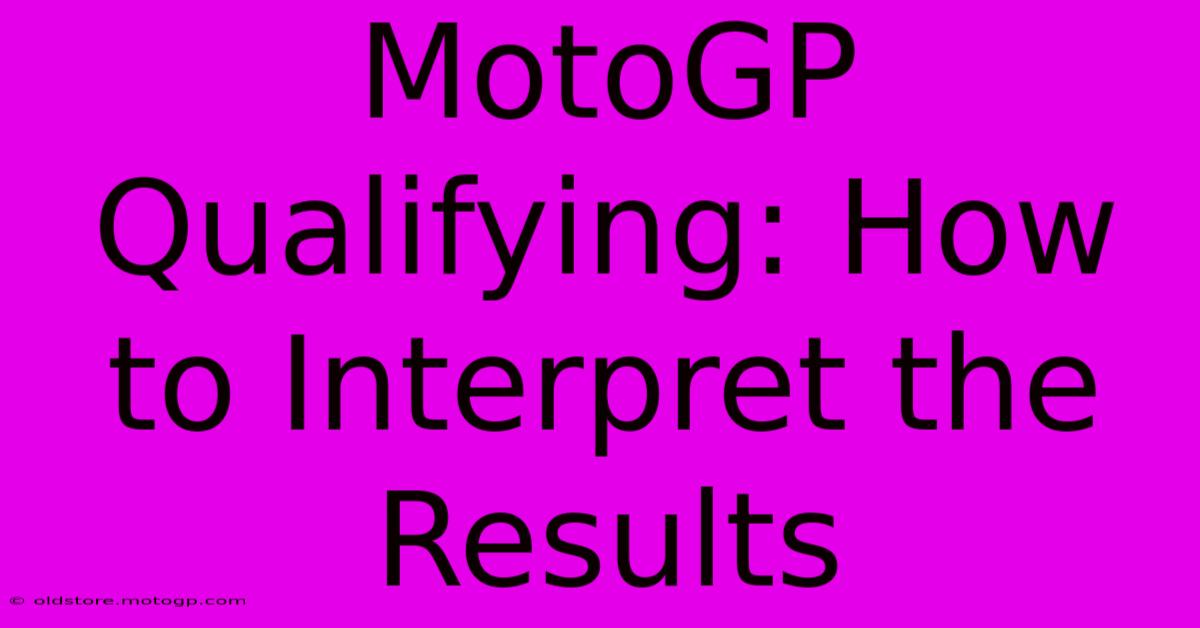MotoGP Qualifying: How To Interpret The Results

Table of Contents
MotoGP Qualifying: How to Interpret the Results
MotoGP qualifying is a crucial part of the Grand Prix weekend, determining the starting grid for the race. Understanding how qualifying works and how to interpret the results is key for any serious MotoGP fan. This guide breaks down the process and helps you decipher the intricacies of the starting grid.
Understanding the Qualifying Format
MotoGP qualifying has evolved over the years, but the core principle remains: the fastest riders start at the front. The current format is designed to be dramatic and showcase the riders' skill. It typically unfolds over three sessions:
FP1 & FP2 (Free Practice): These sessions aren't technically part of qualifying but are vital. They allow riders to test different setups, find the optimal racing line, and get a feel for the track conditions. The combined times from these sessions determine which riders progress directly to Q2.
Q1 (Qualifying 1): The slowest riders from FP1 & FP2 compete in Q1. Only the top two riders from Q1 advance to Q2. The remaining riders start from positions 13-20 on the grid, based on their Q1 times. This session is often high-stakes and nail-biting as riders fight for those precious two spots.
Q2 (Qualifying 2): This session includes the top 10 riders from FP1 & FP2, plus the two fastest riders from Q1. The grid positions 1-12 are decided based on the times set in Q2. The rider with the fastest lap time claims pole position.
Deciphering the Results: More Than Just Positions
The final qualifying results provide more than just the starting order. Here's what you should look for:
-
Pole Position: This is the coveted top spot on the grid. The rider achieving pole position usually has a significant advantage at the start, though it's not a guarantee of victory.
-
Gaps between riders: The time differences between riders offer important insights. A small gap suggests a very close battle for positions and promises exciting racing. A larger gap indicates a clear performance advantage for the faster riders.
-
Consistency: Analyzing a rider's lap times throughout qualifying reveals their consistency. A rider with consistently fast laps is likely to be a stronger contender than one who only sets a fast lap on a single occasion.
-
Tyre choice: Observing which tyre compounds (soft, medium, hard) riders choose in qualifying can give hints about their race strategy.
-
Track conditions: Keep in mind that weather conditions, track temperature, and even the amount of rubber laid down on the track can significantly influence qualifying times. A rider's performance should always be viewed within the context of these conditions.
Factors Influencing Qualifying Performance
Several factors influence a rider's qualifying performance beyond just their skill:
-
Bike Setup: A perfectly tuned motorcycle is paramount for achieving fast lap times.
-
Rider Fitness: MotoGP racing is physically demanding, and rider stamina plays a role in consistently setting quick laps.
-
Team Strategy: Teams carefully plan their qualifying strategy, deciding when to make a qualifying run and how many laps to perform.
-
Tire Management: Managing the tires effectively throughout qualifying is crucial as tire degradation can significantly impact lap times.
Using Qualifying Results to Predict Race Outcomes
While qualifying results don't guarantee race results, they provide valuable clues:
-
Front row starters: Riders starting on the front row typically have a better chance of winning, but overtaking is possible, especially in the opening laps.
-
Consistent performers: Riders who have consistently performed well throughout the weekend, including qualifying, are usually better equipped to handle the race distance.
-
Unexpected results: Qualifying surprises can happen, so it's always wise not to write off any rider entirely.
By carefully analyzing MotoGP qualifying results, taking into account the factors mentioned above, you can gain a much deeper understanding of the race, leading to a more enriching viewing experience. Enjoy the thrill of the race!

Thank you for visiting our website wich cover about MotoGP Qualifying: How To Interpret The Results. We hope the information provided has been useful to you. Feel free to contact us if you have any questions or need further assistance. See you next time and dont miss to bookmark.
Featured Posts
-
F1 Parking Easy Access To The Circuit
Feb 18, 2025
-
F1 In Houston A Weekend You Wont Forget
Feb 18, 2025
-
F1 Qualifying Today Analyzing The Results
Feb 18, 2025
-
The Psychology Of Motorcycle Riding Explored By Famous Riders
Feb 18, 2025
-
Austin F1 Map Find The Best After Party Spots Near Cota
Feb 18, 2025
